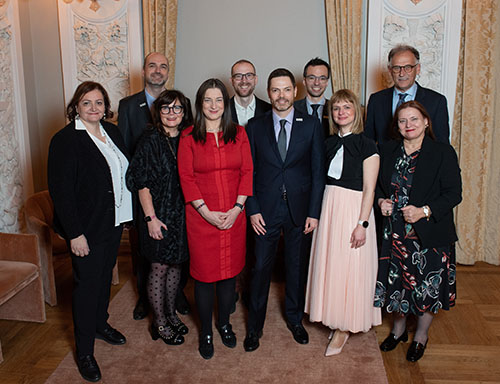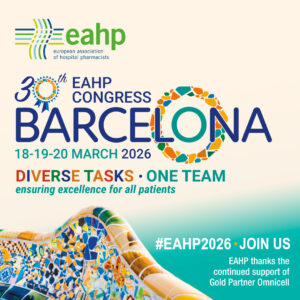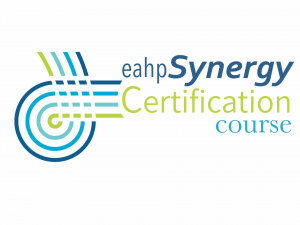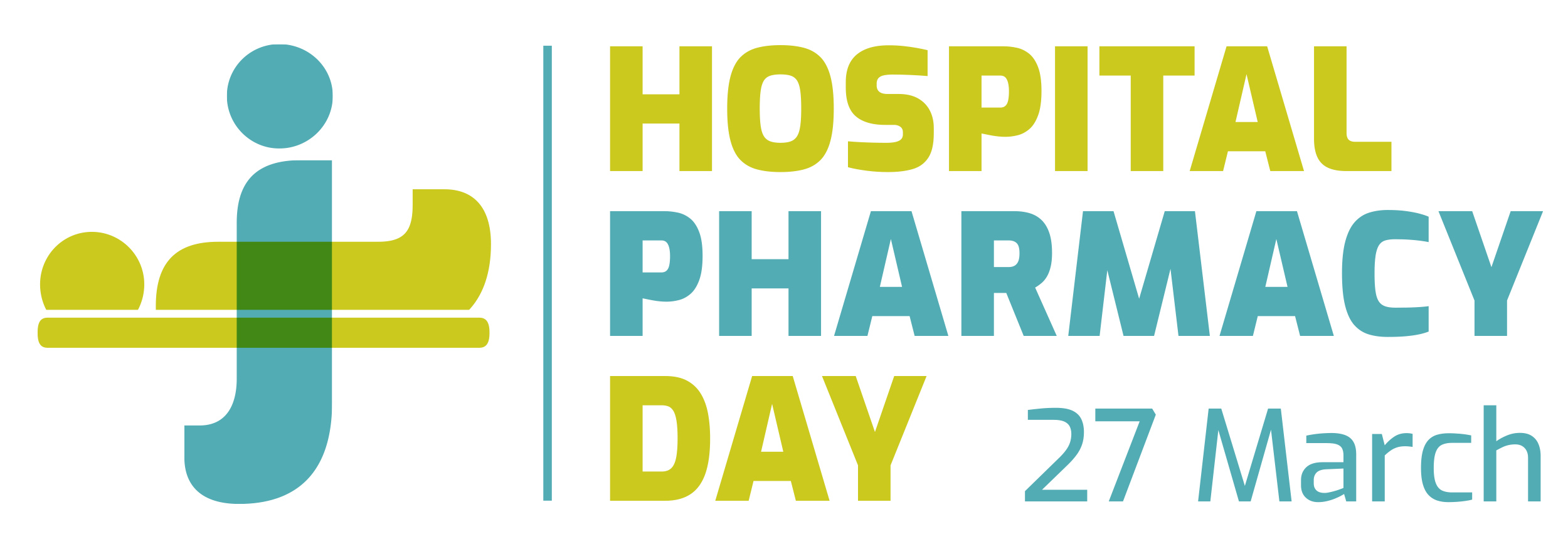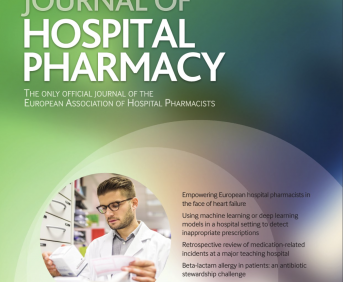IMPLEMENTATION OF A MEDICATION RECONCILIATION PROGRAMME UPON DISCHARGE (submitted in 2019)
Pdf

European Statement
Patient Safety and Quality Assurance
Author(s)
José Marco-del Río, María Luisa Ibarra-Mira, Gregorio Romero-Candel, Ana Ramirez-Córcoles, Ana Valladolid-Walsh, Francisco Tomás Pagán-Nuñez
Why was it done?
Our main goal was to improve patient’s safety, because we noticed that many patients did not take actually all the drugs that were prescribed by the physicians, and other times there were drugs that the patients were taking because they had an active prescription, but they were not supposed to. Additionally, we aimed to improve the drug-related information that the patients take home.
What was done?
A programme which includes every patient admitted into the Internal Medicine department. It consists of three steps: clarification of chronic medication that the patients are taking, we handle them and updated schedule of their drugs upon discharge and we check the coherence with the active prescriptions.
How was it done?
We interview the patients during the admission in order to clarify and update the chronic medication that they are taking. When a patient is about to be discharged, the nurses call us, so at this moment we talk to the physician to know what changes are going to be made on the medication. To coordinate with the physicians and nurses, we had two meetings in which we established the timing of the programme, so the patients don’t have to wait too long for us. When we know the changes that the physician is going to make, we update the medication schedule to handle it to the patients or their family, and we explain to them the changes and how they should manage the new drugs. If any discrepancy or medication-related problem is detected, we talk to the physician to solve it.
What has been achieved?
In the last four months, we performed 180 discharges and we solved together with the physicians 20 discrepancies. Patients are now receiving more comprehensive information about their treatment.
What next?
To continue with the programme and broaden it to the rest of our hospital departments. Also we are working on a way of uploading our pharmacy schedules to the electronic medical record of the patients, so they can be available for every healthcare worker, which would improve even more the transitions of care.
PROCEDURE TO ENSURE CORRECT MEDICATION MANAGEMENT IN THE PERIOPERATIVE PROCESS (submitted in 2019)
Pdf

European Statement
Patient Safety and Quality Assurance
Author(s)
Noelia Vicente Oliveros, María Muñoz García, Álvaro Ruigomez Saiz, Montserrat Ferre Masferrer, Teresa Bermejo Vicedo, Eva Delgado Silveira, Lucía Quesada Muñoz, Ana María Alvarez-Diaz
Why was it done?
An analysis of the indicators of the perioperative process reflected the need to improve their quality. One of the causes of scheduled surgery cancellation was the lack of the follow up of the anaesthetist’s medication recommendations. Medications need to be carefully managed to prevent perioperative complications.
What was done?
We designed and implemented a flow chart to ensure the patient compliance of anesthetist’s medication recommendations prior to surgery. We designed a protocol for the perioperative medication management.
How was it done?
A multidisciplinary group was formed with the management of the hospital and representatives of all the services involved in the perioperative process. The group designed the flow chart of the process by consensus. Patients were candidates to enter in this process if they were on treatment with anticoagulant or 2 or more medications from the following groups: antiplatelet, antihypertensives, antidiabetics. A pharmacist called by phone three times (the day before, the day of medication change, and the day after) to the patient to ensure the compliance of anaesthetist recommendations. If there was a lack of compliance, the pharmacist contacted the surgeon who was in charge of deciding if the surgery procedure continued as scheduled. Moreover, the domiciliary medication of these patients were reconcilliated and recorded in their health record. Healthcare professionals could consult it during hospital stay. The group designed a protocol for the perioperative medication management with different medical specialists.
What has been achieved?
The project started in April 2019. The pharmacist called patients with scheduled surgery of lower limbs. A total of 31 patients benefited from the new flow chart. The pharmacist detected 38 medication errors; two involved errors concerning the suspension of anticoagulant drugs prior to surgery and four implied antihypertensive drugs. Once, it was necessary to contact the surgeon. In this case, the surgeon decided to continue with the surgery as schedule. Fifty-seven medications suffered a change in the period between the anaesthestic visit and the surgery, nine of them belonged to the monitored medication group.
What next?
The next steps are to spread the flow chart to other patients, to distribute the protocol among hospital healthcare professionals and to implement a procedure for the reintroduction of the modified medication.
SAFETY IMPROVEMENT IN PAEDIATRICS: ASSISTED PRESCRIPTION OF INTRAVENOUS MIXTURES (submitted in 2019)
Pdf

European Statement
Patient Safety and Quality Assurance
Author(s)
Iván Maray Mateos, Miguel Alaguero Calero, Adrián Rodriguez Ferreras, Cristina Calzón Blanco, Cristina Álvarez Asteinza, Lucía Velasco Roces, Ana Lozano Blazquez
Why was it done?
Intravenous drugs in the paediatric population bring up additional issues than the usual in adults. In their prescription, not only does the dose have to be adapted to the patient’s weight, the volume in which the drug is diluted must also be adapted to the reduced fluids requirement without jeopardising the stability of the mixture. In view of these facts, IV drug prescription in paediatrics implies a higher risk of medication errors. This new prescribing system simplifies prescription and reduces risks.
What was done?
Development of an assisted prescription system of intravenous mixtures adapted to paediatric patients in which both the drug dose and the diluent volume are automatically calculated according to the patient’s weight.
How was it done?
A literature review of drug dosing in paediatrics and their stability in different diluents was performed. For every drug the following parameters were considered: maximum dose in children (mg/kg), maximum concentration allowed (mg/ml), common doses and volumes in adults. Using these values, a system was built which calculated drug dose and diluent volume according to the patient’s weight and the maximum concentration allowed for stability reasons. For safety and to ease the preparation, the diluent volume in millilitres was rounded up to the next 10. In order to avoid overdosing overweight or older paediatric patients, maximum dose and diluent volume were narrowed down to the usual quantities in adults. Ultimately, this system was integrated in the electronic prescription system. A protocol was created, named “drug name” IV mixture PEDIATRICS. So, by selecting this protocol in a specific patient, the target dose and the diluent volume are automatically calculated.
What has been achieved?
This system was implemented for 38 drugs. From July 2018 to April 2019, 910 IV mixtures have been prescribed from the following Anatomical Therapeutic Chemical (ATC) groups: A02 Drugs for acid related disorders (39), J01 Antibacterials for systemic use (287), J02 Antimycotics for systemic use (3), J05 Antivirals for systemic use (8), A04 Antiemetics and antinauseants (175), N02 Analgesics (395), N03 Antiepileptics (3).
What next?
This method could be implemented in other electronic prescription programmes. The system must be updated by the Pharmacy Department, introducing new drugs and constantly reviewing stability databases, posology regimens, and information regarding dilution of parenteral drugs.
DRUG SERIALISATION: ORGANIZATIONAL AND ECONOMICAL IMPACTS FOR HOSPITAL PHARMACIES (submitted in 2019)
Pdf

European Statement
Selection, Procurement and Distribution
Author(s)
Quentin HIVER, Agathe ROGER, Marine EGOT, Ivan VELLA, Marie-Hélène TYWONIUK
Why was it done?
Community and hospital pharmacists are required to apply the European directive on falsified medicines. In France, we are currently undergoing a transition phase for the progressive generalisation of serialisation. French pharmacies are more or less ahead of schedule for the implementation of decommissioning. In our pharmacy, the decommissioning has been operational since February 2019. After 8 months of practice, we are able to provide data as a basis for work and thinking.
What was done?
Determining and evaluating, by feedback approach, the organisational and economical impacts of drug serialisation for a hospital pharmacy
How was it done?
• Step-by-step description of the supply chain after implementation of decommissioning. • Collection of the man-hours necessary for: decommissioning implementation, software training, routine decommissioning, problem solving. • Census of financial investments
What has been achieved?
After analysis of our supply chain, the reception stage appeared to be the most favorable for decommissioning, in terms of practicality, safety and traceability. Several steps have thus been added at reception: Identification of serialized boxes, manual scan, checking of the decommissioning report and the number of decommissioned boxes, printing of the report. The pharmaceutical time necessary for the decommissioning implementation has been estimated to up to 28 hours. The software training was made in small groups of 2−3 agents, requiring 9 minutes per agent on average. The decommissioning is currently requiring 17 minutes for 100 boxes. Over 8 months, the time necessary for the pharmacists to solve problems linked with serialisation (non-operational Hub, corrupted database, error message at decommissioning…) was estimated to up to 7 hours. The financial investment amounts to 17200 euros (software+ergonomic desk+man-hours at implementation).
What next?
The decommissioning itself doesn’t have a major impact on the pharmacy’s organization. But, ensuring a clear and safe supply chain, to identify which boxes must be decommissioned and which boxes can be dispensed, is time-consuming. It goes through a proper working environment with a forward supply chain and traceability tools. Moreover, the encountered problems were mainly due to computer failures, requiring a performing software with an efficient maintenance. We are currently working on improving the ergonomics of the workstation to avoid the risk of musculoskeletal disorders due to decommissioning.
IMPLANTATION OF A COMMUNICATION CIRCUIT OF ALERTS AND SAFETY NOTES RELATED TO DRUGS FROM THE PHARMACY DEPARTMENT (submitted in 2019)
Pdf

European Statement
Patient Safety and Quality Assurance
Author(s)
Ignacio García Giménez, Natalia Martín Fernández, Olalla Montero Pérez, Ernesto Sánchez Gómez, Isabel María Carrión Madroñal
Why was it done?
The aim is to implement a protocol to follow when these safety notes/alerts are released from the AEMPS. It comprehends the reception of the information, its registration and its communication, when needed, to the rest of the healthcare professionals.
What was done?
A communication circuit of alerts and safety notes related to drugs coming from the “Agencia Española de Medicamentos y Productos Sanitarios (AEMPS)”.
How was it done?
At the reception of an alert from the AEMPS, the first step is to check if the drug has been acquired by the Pharmacy, and then act in accordance with the recommendations, informing the Departments in which the medication had been dispensed. If a drug must be retired and a stock break is generated, the healthcare professionals must be informed as well. Security notes from the AEMPS are published in the local hospital website, where the documents sent by the AEMPS can be found. If this medication is included in the Pharmacotherapeutic guide, a notification is shown when it is prescribed. Finally, all alerts and security notes, with the pharmacist intervention, are registered in a database.
What has been achieved?
Since the implementation of the circuit, 14 alerts and 9 security notes were sent from the AEMPS in a period of 6 months. No interventions regarding the alerts were needed. Healthcare professionals were informed when the security notes were released, pointing to the patients at risk, the precautions required and the alternative therapies available.
What next?
To incorporate it as an indicator of quality of care within the procedures performed by the pharmacy department and detect areas of improvement.
A QUALITY IMPROVEMENT PROJECT ON HEPARIN INFUSION SAFETY IN AN ACUTE TEACHING HOSPITAL (submitted in 2019)
Pdf

European Statement
Patient Safety and Quality Assurance
Author(s)
Anthony Hackett, Alice Oborne, Emma Ritchie, Caroline Broadbent, Rebecca Chanda, Karen Breen
Why was it done?
Anticoagulants such as UFH are recognised as high risk drugs. UFH requires frequent monitoring of the activated partial thromboplastic time ratio (APTTr), ensuring therapeutic anticoagulation and minimising adverse effects. UFH infusions and the APTTr were recorded using a paper based system. Incident reporting identified by the paper system resulted in inappropriate monitoring and management of UFH infusions, and dose omissions which could have resulted in harm.
What was done?
A Trust-wide electronic prescribing and medicines administration (EPMA) system was implemented in 2015. Complex infusions, e.g. unfractionated heparin (UFH) infusions, remained on paper due to EPMA functionality limitations. The complex infusion function was added into later EPMA upgrades. A multidisciplinary team (MDT) involving nursing, medical and pharmacy staff working within anticoagulation, EPMA and medication safety sought to design UFH infusions in EPMA.
How was it done?
Baseline audit (Paper-March 2016): Patients prescribed UFH infusions (n=14) were identified using SharePoint (e-reporting) by searching for the UFH infusion placeholder. Performance was measured against eight audit standards.
Re-audit (EPMA-March 2019): Patients prescribed UFH infusions (n=26) were identified using SharePoint by searching for those prescribed a UFH infusion on EPMA. Performance was measured against the same eight audit standards.
Chi square applied to results to test for statistical significance.
Incident rate per prescription: The Datix system was searched to identify heparin incidents reported during the data collection periods.
What has been achieved?
Audit standard 2016 audit v 2019 audit
1-Baseline APTTr checked before starting infusion 93% v 100%, p=0.1
2-Received correct loading dose of heparin based on APTTr 79% v 96%, p=0.07
3-APTTr checked 6 hours after infusion started 72% v 100%, p<0.05
4-APTTr checked 6 hours after infusion titrations 86% v 96%, p=0.2
5-APTTr in target range within 24 hours 50% v 70%, p=0.2
6-APTTr checked 24 hourly after 2 consecutive APTTr’s in range 100% v 100%=no change
7-Patient receives a medical review 24 hrly 65% v 100%, p<0.05
8-Heparin syringe and giving set changed 24 hrly 65% v 100%, p<0.05
UFH related incidents reduced from one incident per 1.6 infusions, to one incident per 6.5 infusions following the implementation of an EPMA system.
UFH incidents as a proportion of all anticoagulant incidents reduced from 43% (March-2016) to 20% (March-2019).
What next?
Electronic solution’s for high-risk, complex infusions such as heparin prescribing and monitoring improved care, quality and safety. Further high-risk infusions such as insulin are being developed
MANAGING MEDICINES SHORTAGES ON A NATIONAL LEVEL – A MULTIDISCIPLINARY COLLABORATION BETWEEN WHOLESALER, HOSPITAL PHARMACIES AND PATIENT SAFETY ORGANISATION IN DENMARK (submitted in 2019)
European Statement
Selection, Procurement and Distribution
Author(s)
Christine Dinsen-Andersen, Hanne Fischer, Anita Gorm Pedersen, Dagmar Bertelsen, Marianne Hald Clemmensen
Why was it done?
Before the NTF was established, each hospital pharmacy made their own assessments and solutions to CMS. This led to a lack of coordination in the national supply and knowledge sharing. As the number of CMS increased, a need for a coordinated national initiative became evident. The aim of the NTF is to secure better communication to healthcare professionals and to establish clearly defined rolls and responsibility in the supply chain from wholesaler to hospital pharmacy. Patient safety aspects should be included in all relevant steps of the process.
What was done?
A National Task Force (NTF) for critical medicines shortages (CMS) have been established with the main objective to provide therapeutic and patient safety assessment of CMS on a national level. In addition to this the NTF takes considerations regarding the supply chain into account in the assessments.
How was it done?
To secure national engagement, members of the task force were appointed according to a consensus between the hospital pharmacies in Denmark. The NTF includes participants from 3 hospital pharmacies, the national wholesaler for hospital pharmacies and a patient safety organization. Based on challenges of geographical dispersion and different local practices, an effort was put into: • securing a systematic work flow, for the group; • creating a digital platform with access for members from different organizations; • agreeing on when a medicine shortage is critical.
What has been achieved?
• Early intervention – resulting in opportune solutions. • Agility in allocation of remaining stock between hospital pharmacies. • Optimisation of choice of alternative treatment during period of shortage. • Secure supply of alternative drugs on national level. • Initiate agreement between physicians on choice of alternative on a national level. • Attention to patient safety challenges – preventing adverse events.
What next?
Joined forces have resulted in coordinated and optimised solutions to managing CMS, enabling the hospital pharmacies to secure patient safety. Hence the NTF shall continue its work. Having a national unit as NTF provides the basis for coordinated initiatives and for corporation with health and medicines authorities and market authorization holders.
SAFE PRESCRIBING METRICS FOR HOSPITAL PHARMACY (submitted in 2019)
European Statement
Patient Safety and Quality Assurance
Author(s)
Oran Quinn, Anna Marzec
Why was it done?
Errors of miscalculation, doses inappropriate for renal function and at extremes of weight were reported when doses of medication were written as ‘mg/kg’ without stating the dose to be given e.g. Gentamicin 5mg/kg, Vancomycin 15mg/kg and Enoxaparin 1.5mg/kg.
What was done?
A quality improvement initiative to resolve issues with prescribing medications dosed by weight. Nursing staff were identified as ‘gate-keepers’ who could refuse to administer medication inappropriately prescribed. Identification, agreement, education and feedback were necessary to change prescribing practice and support nursing staff. Hospital doctors were required to calculate and prescribe the total dose to be given. Feedback was given by monthly bulletin.
How was it done?
Support from key stakeholders was sought to endorse the initiative. Verbal and written education was given to nursing, medical and pharmacy staff to implement the initiative on an agreed date. Refusal to administer medication unsafely prescribed was key to successful implementation. Patient’s weight was not always available and additional equipment was provided to overcome this problem. The risk of withholding treatment was considered and an escalating referral process was recommended contacting the Senior House Officer, then Registrar and ultimately the patients Consultant to avoid lengthy delays to patient treatment. Nurses felt supported in refusing to administer medication.
What has been achieved?
A point prevalence study of all inpatients was carried out monthly to ascertain the level of compliance Mar-19 Apr-19 May-19 Jun-19 Jul-19 Aug-19 % of patients with total dose prescribed correctly 67.0 86.7 96.7 100.0 100.0 88.9 87.5. Results showed overall improvement from March to August and full compliance in May and June. Success was achieved through a multidisciplinary approach involving all key stakeholders, a forcing function and support from and for front line staff.
What next?
This initiative has been further developed to become ‘Monthly Safe Prescribing Metrics’.
Other prescribing metrics such as using ‘iu’ dosing for Insulin, prescribing appropriately for patients at extremes of weight and using the abbreviation ‘mcg’ for medications dosed in ‘micrograms’ were included. Initiatives to improve all metrics are ongoing.
Safe prescribing metrics could help to positively influence prescribing culture in other healthcare settings.
HERA – A NEW TOOL FOR THE QUALITATIVE AND PHARMACOECONOMICAL EVALUATION OF GENERIC DRUG PRODUCTS BEFORE CHANGING BRANDS (submitted in 2019)
Pdf

European Statement
Selection, Procurement and Distribution
Author(s)
Steffen Amann, Rudolf Bernard, Georg Berndt , Meike Bindemann, Myga Brakebusch, Jörg Brüggmann, Frank Dörje, Miriam Gyalrong-Steur, Anita Kellermann, Markus Müller, Elfriede Nusser-Rothermundt, Rainer Riedel, Eva Tydecks
Why was it done?
Given rising cost-pressure and increasing numbers of supply shortages, changes between generics have become daily practice in hospital pharmacies. To ensure constant treatment quality and patient safety, the equivalence of a potential new product with the current one must be guaranteed before changing brands. So far there has been no transparent, standardised tool for the comparison of generics workable in everyday clinical practice. Developing such a tool was our project’s aim.
What was done?
We developed an Excel-based tool for the qualitative and pharmacoeconomical evaluation of generics before changing brands (aut-idem substitution) in hospitals.
How was it done?
A working-group of pharmacists from seven hospitals developed the “HERA” tool (HTA-evaluation of geneReric phArmaceuticals). Starting from a base version, 22 generic products were assessed with the tool during five evaluation rounds. Based on these results the instrument was gradually refined. Within HERA‘s Excel matrix a potentially to-be-used generic is compared with the current one. The economic evaluation is based on unit prices and prescription volumes, but also includes process costs associated with the product change. The assessment of pharmaceutical quality is based on 34 criteria from six areas (licensed uses, drug substance, dosage form and excipients, handling, safe design, packaging and storage). The objective quality evaluation is complemented by the assessment of hospital-specific features. Complex substitutions – e.g. associated with a handling change – require involvement of the medical staff using the product. The purchasing decision is taken based on the synopsis of pharmaceutical quality and economic evaluation.
What has been achieved?
The standardised evaluation of product differences before substitutions allows for the early identification of potential problems of brand changes and helps avoiding them for the benefit of patient safety. HERA also guarantees reproducibility and transparent, QM-compliant documentation of product changes. The pharmacies of our purchasing group now routinely use HERA for the assessment of generics before intended brand substitutions. Each evaluation is conducted in one pharmacy and shared with the others via data-cloud.
What next?
We have published a paper on HERA and presented it at the German Hospital Pharmacists congress in 2018. Our aim is to create a network of colleagues with shared access to all colleagues’ HERA product evaluations to reduce the workload for the individual pharmacies.
PHARMACEUTICAL ALGORITHMS TO PERFORM MEDICATION PHARMACEUTICAL ANALYSIS (submitted in 2019)
Pdf

European Statement
Patient Safety and Quality Assurance
Author(s)
Arnaud Potier, Béatrice Demoré, Alexandre Dony, Emmanuelle Divoux, Emmanuelle Boschetti, Laure-Anne Arnoux, Cédric Dupont, Jean-Christophe Calvo, David Piney, Virginie Chopard, Nathalie Cretin, Edith Dufay
Why was it done?
Drug iatrogenia costs global health systems $52 billion annually. The third global patient safety challenge aims at reducing the global burden of iatrogenic medication-related harm by 50% within 5 years [1]. Pharmaceutical analysis is a fundamental activity, a regulatory obligation in many countries but remains a challenge. This practice is highly variable. A graphic definition of the target pharmaceutical analysis has been formalised in December 2017 which sets the basis for its digitalisation, effectively implemented since January 2019. The aim is to build a corpus of the most relevant PA to facilitate clinical pharmacist practice.
What was done?
A computerised clinical pharmacy tool is integrated into the health information system of our group of hospitals (5000 beds) to promote efficiency of pharmaceutical analysis in order to improve patient safety. Pharmaceutical algorithms (PA) are conceptualised to improve drug related problems (DRP) detection and their resolution through pharmaceutical intervention (PI) according to a defined conduct to be held: anamnesis of subjective and objective elements of appreciation, DRP characterisation and PI transmission. Pharmaceutical analysis is performed by the use of PharmaClass® (Keenturtle). This software has been interfaced with 5 health data flow of two health facilities (1000 of the 2000 beds were tested): identity and patient flow, medication data, laboratory results examination, medical history, physiological constants. PA are partially encoded as rules in Pharmaclass® that issues alerts analysed by a pharmacist.
How was it done?
Health data are lacking of semantic interoperability which Pharmaclass® aims at overcoming from Electronical health record (EHR) queries in real time. A corpus of PA has been structured integrating the conduct to be held. PA were created by modeling the pharmaceutical experiment with the thread of criticality. PA were validated by consensus.
What has been achieved?
80 PA were encoded into Pharmaclass®: 40 are targeting serious adverse drug events. 1516 alerts were analysed and 539 PI transmitted during the 9-month test period.
What next?
This practice is applicable to any pharmaceutical analysis that uses data from an EHR. Clinical pharmacy societies should host and take care of updating corpus of PA. Its educational interest should be exploited. A European interest group for artificial intelligence in clinical pharmacy is being created.
